Most berries require a lot of water to do well but they taste great and if using drip irrigation with timers you can have success.

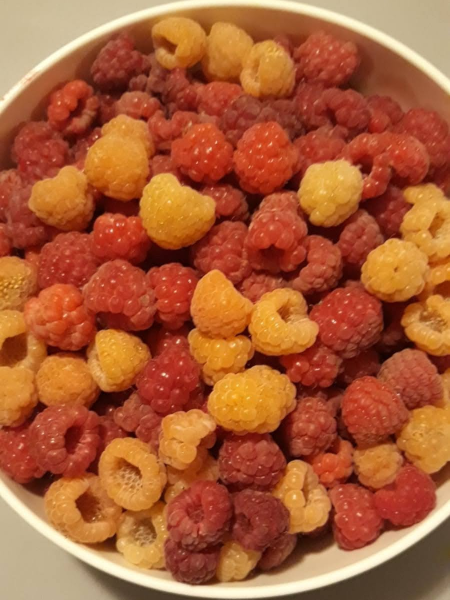
2022 Raspberries
Raspberries once established can produce many berries with little water. I have a couple patches that have a single 1/2 gal/h dripper running for 60 minutes that are producing. Ideally make a bed 18" - 24" deep filled with peat moss to retain water and space drippers every 12 - 18 inches. Peat moss is great for lowering the pH if you needed and retains water well. I tried Hypnum peat on year and it is a little too dense. This year I made new berry bed 32" x 24" x 20' lined with plastic and filled with soil. There was a tear in the bottom of the plastic which we patched so enough water excapes out the bottom to prevent salt accumulation. So far the berries and rhubarb planted there look great and require less water than an unlined bed.
Raspberry varieties can be classified and regular/floricane raspberries produce in summer on 2nd year canes while primocane raspberries produce in fall on first year canes as well as in summer on second year canes like floricane raspberries. Some growers cut primocane raspberries to the ground in winter and the next year harvest only the primocane fall crop but don't do that to floricane raspberries or you won't get any berries! For floricane raspberries only trim off the canes that have already produced a crop and leave the new canes for next years crop. Depending on climate some primocane raspberries may fail to produce before frost, so it is good to select primocane types that produce in early enough for your area. I have noticed for several years in a row that Boyne which is a floricane raspberry does pop out a few berries in the fall but they freeze before ripening.
I have since gotten a taste of both Joan J and Polka and both are good tasting and made very large berries when planted in the new plastic lined bed. They really appreciated the extra water and fertilizer added to the bed. Joan J makes very large tasty berries. The only complaint I have is that since Joan J is totally thornless and the deer have found it and visit nightly to trim the upper parts of the fresh green canes along with the flower buds.
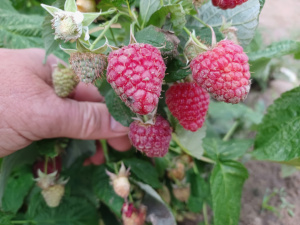
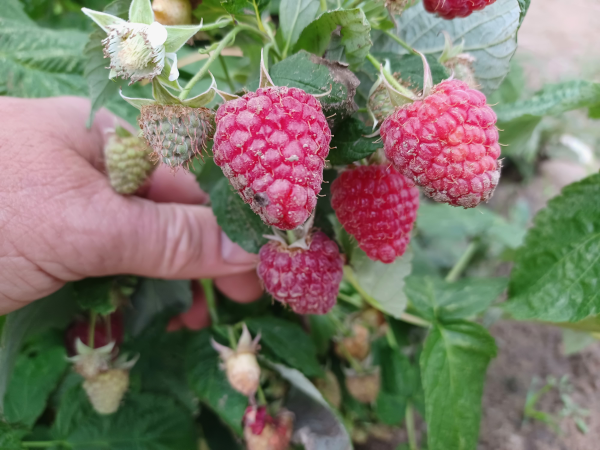
Joan J Raspberry - Very Large Berries
|
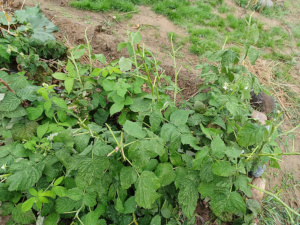
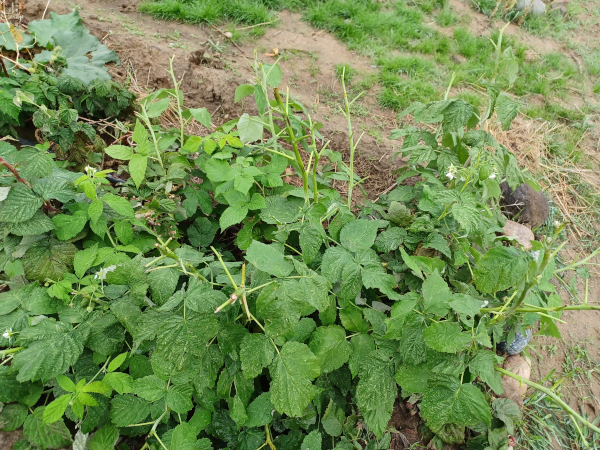
Joan J Raspberry - Deer Damage
|
Primocane Raspberry Varieties
- Anne Yellow Raspberry (very productive, very nice taste, early)
- Double Gold Yellow Raspberry (very productive, very nice taste, mid-early)
- Fall Gold Yellow Raspberry (very productive, very nice taste, mid-early)
- Caroline Raspberry (very productive, mid-early, seems sour but still testing)
- Amity (strong classic raspberry taste, sweet when ripe, smaller canes)
- Joan J (thornless, good tasting, huge berries, ripens early)
- Polka (good tasting, ripens early)
- Heritage (very vigorous and spreads like a weed, ripens too late for fall crop)
- Boyne (very productive, cold hardy, tries to make a fall crop - sometimes)
- Honey Queen Yellow (does not seem vigorous, no fruit yet)
- Canby (nice taste, few thorns, vigorous, not as cold hardy as Boyne, removed)
- Coho (very nice taste, vigorous, not very cold hardy, removed)
- Meeker (not cold tolerant at all, dies back in winter, no fruit, removed)
- Brandywine (purple, extremely small berries, pulled them all out with a vengeance)
Some black raspberry varieties have a different tolerance of raspberry viruses and it is recommended that they be planted 100' or more away from other red, yellow, purple, or wild raspberries.
- Jewel (larger berries than Munger, sweet, the best black raspberry I have)
- Munger (nasty thorns, plant can get huge, sweet, mid sized, very productive)
- Niwot (primocane, just now getting big enough to produce)
- Sweet Repeat (primocane, the ones I have tried were very sour so far)
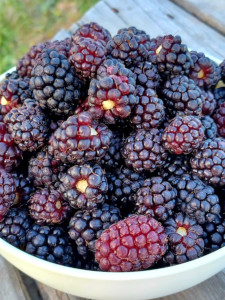
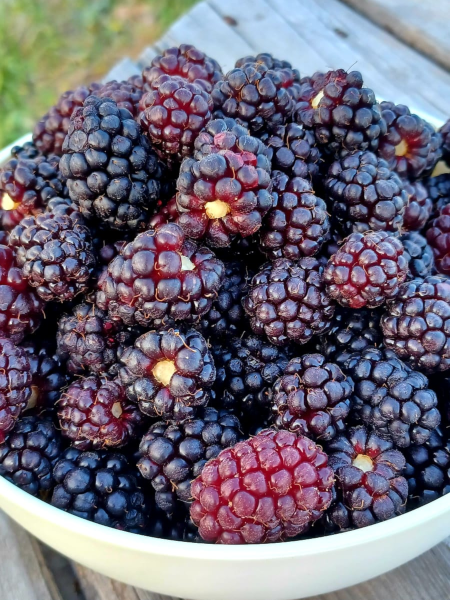
2022 Blackberries & Boysenberries
Blackberries prefer cool summers, mild winters, and a lot of water. We have hot summers, cold winters, and I do not advise growing blackberries if water is an issue.
Blackberries require more water to do well and are not as cold hardy as raspberries. There are cold hardy types of blackberries and sensitive ones can be protected during winter months. I have tried multiple plants and a number of varieties. Of the blackberries I've tried the Thornless Boysenberry seems like it has the most potential for increased yield and good taste with less maintenance. It does revert sometimes producing thorny canes and can be easily tip rooted. It has trailing canes which can get long and I tried to v-trellis them but despite their apparent cold tolerance in previous years the canes died back. The canes need to be near the ground and it is best if they are covered by snow during winter. In the spring, train them to a trellis with ties not weaving and lay them back on the ground in the fall. Weaving is more work and damages the canes when transferring. Black Satin and Heaven Can Wait are also cold hardy and are upright types. Marion and Columbia Star taste great and are trailing but need to be covered during winter. Cover with hay and greenhouse plastic, fold the plastic around 2x6's, put hay under the wood, and use rocks keep the edges down.
- Thornless Boysenberry (very cold tolerant, trailing, good taste, easy to grow)
- Heaven Can Wait (thornless, upright, cold tolerant, nice taste, best upright)
- Black Satin (thornless, very cold tolerant, seems dry and seedy)
- Marion Berry (must protect from cold, trailing, very good taste, very thorny)
- Columbia Star (must protect from cold, trailing, good taste, thornless, not as productive or vigorous as Marion)
- Apache (thornless, still testing only 1 plant)
- Arapaho (thornless, very upright, needs some protection to produce well, dry)
- Chester (thornless, not vigorous, no berries yet, only 1 plant)
- Kiawa Giant (thorny, cold sensitive will not produce well without good protection)
- Naches (thornless, needs some protection to produce well)
- Navaho (thornless, needs some protection to produce well, good sweet taste, 2nd best semi-upright)
- Ouichita (thornless, needs some protection to produce well)
- Triple Crown (thornless, needs protection, not suitable or vigorous for this climate)
- PrimArk Freedom (thornless, needs protection to produce well, primocane ripens too late)
- PrimArk45 (thornless, needs protection to produce well, primocane ripens too late)
- Von (thornless, still testing 3 plants)
Strawberries


Quinault Strawberries - Fall After Drought
|

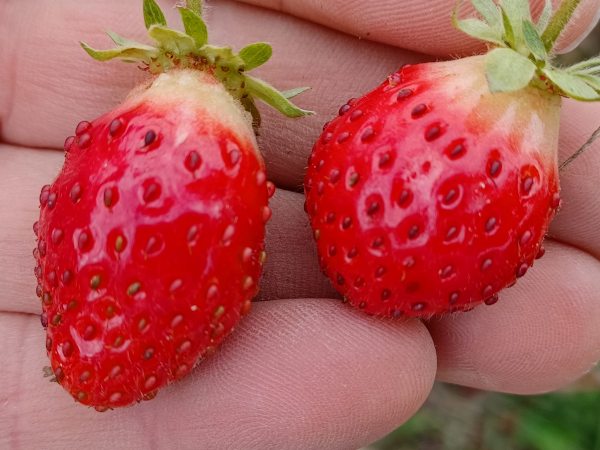
Quinault Strawberries - Fall After Drought
|


2022 Strawberries
|
Strawberries are extremely productive but given enough water most varieties spread uncontrollably. Quinault produces berries all year (usually in the Fall) and makes few runners, but can be propagated easily by division. In mid summer 2023 the Quinault turned totally brown and we did hand water a few times (the drippers had been reduced to 20 minutes per day). After fall rains they turned green again and produced well. They are smaller than most commericial store bought varieties but more flavorful and sweeter. The other variety I recommend is Hula berries because they are still barely pink when ripe and not as easily noticed by birds.
I have several other varieties including Allstar and Ozark Beauty and one I just call big runner because it came without a label, makes big berries in the spring, and makes a lot of runners. I might be replanting these as they produce in early summer when there is still water in the ground and generally strawberries seem to tolerate periods of drought well.
- Quinault (great taste, few runners, everbearing)
- Hula Berry (great taste and not easily noticed by birds)
Saskatoon or Service Berries
These berries are extremely drought tolerant, in the apple family, and have a very nice sweet taste. I know of one 8 feet tall that has never been watered growing on the rocky slope in the wild where very little else is growing. That being said to produce well they need some water. I planted 5 varieties 2 years ago and added 20 Northline this year and will add 20 Thiessen next year. According to reviews Northline and Thiessen are top producers and of commerical quality.
- JB30
- Lee 3
- Lee 8
- Martin
- Northline
- Thiessen (to be added)
Gooseberries & Currants
These are very cold hardy ribes with leaf out and produce early in the spring. The only ones I'd spare water for are the Jostaberries, Crandall Black Currant, and Hinomaki Yellow Gooseberry. The Black Currant makes an impressive display of small yellow trumpet shaped flowers every spring followed by many tasty berries with unnoticable seeds.
My favorite gooseberry Hinomaki Yellow died back and resprouted in 2023 and then the grasshoppers ate all of the leaves and green stems. I moved it to a non-plastic lined location and flushed with water, gooseberries may be salt intolerant.
- Black Currant Crandall (thornless, very productive, small grape sized fruit, slightly sweet tart)
- Jostaberries (nice, sour, dry right on the bush, like dried cranberries)
- Hinomaki Yellow Gooseberry (smaller thorns, bigger greenish fruit with a very nice sweet crisp lemony taste)
- JeanAnne Gooseberry (very small thorns, bigger fruit, not impressed with taste yet)
- Black Velvet Gooseberry (thorny, still small)
- Invicta Gooseberry (very thorny, still small)
- Gooseberry (thorny, size and taste unimpressive except Hinomaki Yellow)
- White Currant & Red Lake Currant (sour, tiny, seedy, pulled out with a vengance)
Honey Berries
There is a honeyberry craze and online content promoting their great taste but I think they still need to be perfected. They ripen very early but many varieties seem to have an astringent taste and don't get sweet enough till soft and dropping on the ground. They are not easy to harvest and easily damaged when picking, but again so are many berries. The variety I suggest is Aurora which is larger than most and can be quite nice if ideally ripe but it needs a suitable pollinator. The good thing about honeyberries is they taste similar to blackberries, do not require a low pH, and do not require excessive amounts of water. I have more than 15 types planted in plastic lined holes and they are doing well with 1 or 2 drippers. Even when not planted with in a plastic lined hole they grow with a single dripper.
- Aurora (best I've tried so far, can be very nice tasting)
- Blue Banana (should pollinate Aurora)
- Blue Sea
- Blue Mist
- Boreal Beast
- Boreal Beauty
- Boreal Blizzard
- Honey Bee
- Honey Glen
- Honey Joy
- Strawberry Sensation
- Taka
- Tana
- Tundra
Ground Cherries
Sweet tomato like fruits with papery covering, extremely drought tolerant, grow close to the ground when hot and windy, taste good not as fruity tart like Physalis peruviana. They are extremely productive and reseed themselves easily. They sprout crowded together so I thin them and pull out the ones I don't want. There are several species of physalis called ground cherries and are easily mistaken for Poha Berries. There are some types that are also called Cape Gooseberries.
- Gooseberries - Ribes (currants, blackcurrants, and gooseberries)
- Cape Gooseberries - (Physalis spp.)
Poha Berry - Physalis peruviana
Will the real Physalis peruviana please stand up! I have grown many types of physalis and I have never gotten a real Poha Berry seed when bought from a seed store or ordered online. The only way I have gotten real Poha Berry seeds is by buying Golden Berries from the store and saving the seeds. These are tart mango tasting gold tomato looking fruit with a papery covering. They are slower growing and have not been as productive as ground cherries, but they are reasonably drought tolerant and probably need a longer season than ground cherries.
Tomatillos - Physalis ixocarpa
These are related to ground cherries and have much larger fruits. Yellow and purple tomatillos are also sweet, drought tolerant, grow easily, and productive.
Wonderberries
- Wonderberries (Solanum burbankii)
- Garden Huckleberry (Solanum melanocerasum)
- Garden Huckleberry (Solanum nigrum)
- Huckleberry (several plants in the blueberry family Ericaceae)
These little berries were developed by Luther Burbank though there is some dispute as to their origin and his involvement. They are in the tomato family are closely related to and sometimes mistaken for garden huckleberry which has larger fruit and grows taller with longer internodes. Wonderberries are extremely drought and poor soil tolerant, sweet when ripe, and have a bit of a anise flavor. My wife doesn't like them but I do. A single plant can grow several feet wide and 30 inches tall just like a tomato plant but with 100's of dusky black pea sized berries. They ripen unevenly and the green ones are high in solanum (tomato/potato leaf toxin which can cause liver damage) but they are edible when fully ripe (purple and dusky not shiny). I had grown them before and recognized a wonderberry and blackberry growing in the pot of a peach tree and bought the tree. Wonderberries reseed themselves every year and even colonized (along with a ground cherry) the top of an 8 foot high pile of dry rocky soil I excavated for pit setting our mobile home. Very tough plants but please get them or seeds from a reputable source and do not confused them with nightshade which also looks similar.
Blueberries
Blueberries are very productive and great tasting but require an acidic soil with a pH 4.5-5.5 to be able to do well. I have grown them successfully for several years with bumper crops off of 16 plants but they do require extra effort. All the varietes I have tried seem to produce pretty well. Dig out a 2.5ft deep x 2.5ft wide hole and replace the soil with 100% peat moss, it is acidic. I make my own hydroponic solutions using raw ingredients and pH adjusters. Several acids can be used to drop the pH but are metabolized quickly but sulfuric acid will keep the pH down for a longer period. Fertilizer salts buffer the pH so I usually make a fertilizer solution, adjust to pH, then water the blueberries. A less work intensive method would be to top dress and then water as needed with pH adjusted water. Another option is to mix a generic water soluble fertilizer following the directions and pH the solution to 3.8-4.5 before watering, assuming your regular water has a high pH.
I am not advising anyone to use sulfuric or battery acid, it is extremely caustic. It will burn your skin, eyes, clothes, and anything else it comes into contact with. I have over 10 years laboratory experience and it is my personal choice to use sulfuric acid to adjust the pH of my fertilizer solution to put on my blueberries.
Battery acid is extremely dangerous and can cause burns to skin or blindness or worse. My 3 year old container had degraded and I put my hand right through the lid and into the acid. I wear glasses so my eyes were protected. I immediately realized what I had done and flushed with running water that I had right next to me and I was ok. I took off my pants and soaked with water and they were okay, I did not soak my shirt and after next laundry it was full of holes. When ever mixing any kinds of sprays or chemicals follow the directions on the label, use appropriate precautions, use protective equipment, use glasses or goggles, and keep a supply of fresh preferably running water nearby.
When I want to adjust pH for blueberries, I buy 4 gallons of battery acid and pour 1/3 in an old 5 gallon fertilizer container to dilute and save the rest for later. I then dilute the 1/3 with 2 parts water (so 10% acid) then use 6 cups of that for a 200 gallon hydroponic fertilizer mix to get the pH to 3.8-4.5. I water the blueberries every 2-4 weeks with it because the drippers 2 per plant 1 gallon per day at pH 8.2 will slowly raise the pH back up. I used Dr pH meter but it didn't last more than 2 years and probably pH paper is cheaper. It may take more or less acid to achieve the desired pH depending on the initial pH and buffering capacity of the water.
- Duke
- Patriot
- Blue Gold
- Eariblue
- Toro
- BlueCrop
- BlueJay
- Chandler
- Blue Profusion
Fertilizer 757082ml = 757082g = 200gals
| 1 Gal Micronutrient Stock | |
|---|---|
| Usage: 50ml per 50Gal or 200ml per 200 Gal | |
| Boric Acid | 63g |
| Maganous Chloride | 57g |
| Cupric Chloride | 3.1g |
| Molybdenum Trioxide | 1.3g |
| Zinc Sulfate | 9.9g |
I have tried many organic and inorganic combinations including urea, bloodmeal, bonemeal, alfalfa meal, potash, gypsum, epsom salt, fish emulsion, lagbenite, KPO4, K2SO4, CaNO4, and others and the N and K should be about 220ppm while P 40-80ppm. For each component calculate the ppm's, make a table, and add the resulting ppm's together. Percentage is he actual percentage of an ingredient in the fertilizer for example many molecules contain other elements like Hydrogen, Oxygen, or Sulfur and some fertilizers contain more than one nutrient so you'll need to make a table if making your own formula. If you want to go all organic good choices are fish emulsion, bonemeal, potash, epsom salt, and gypsum. For liquids just weigh the liquid in grams and multiply by the NPK for example 5-1-1 take 100g multiply by 0.05 for N and follow he formula below. Do this for each of N, P, and K. Bonemeal has both calcium and phosphate but is not very soluble so better to add separately or as a powder but follow the instructions as it can easily burn plants. I would only add gypsum if the soil is low in calcium and it is not very soluble so may be better to add as a top dressing.
You'll need EDDHA Iron Chelate (high ph availability) for best results with blueberries. For Iron Chelate follow the rates on the package and use the highest amount if your soil pH is high. If the soil is acidic (low pH) Iron Sulfate can be used which is less expensive but requires more of it to get the same results.
To convert ppm to grams
Formula: ppm / 1000000 * ml / % = grams
Example: To calculate 80ppm each of N P K for 15-15-15 for 50 gals.
80ppm/1000000 * 189271ml = 50 Gal / 0.15 = 100.9 grams to add for 50 gallons
You will still need to weigh to make a recipe by volume.
To convert grams to ppm
grams * % / ml * 1000000 = ppm (where 0.15 is percent of ingredient like K)
Example 2
100g Urea * 0.46 / 189271ml * 100000 = 243ppm Nitrogen (50 gallons)
400g Urea = 243ppm (200 gallons)
| Hydroponic Fertilizer 757082ml = 200 Gals | ||||||||
|---|---|---|---|---|---|---|---|---|
| Usage: water plants directly | ||||||||
| N | P | K | Mg | Ca | Fe | Notes | ||
| 1.5 cups | 15-15-15 NPK | 80 | 80 | 80 | 0 | 0 | 0 | |
| 1.5 cups | CaNO3 | 166.6 | 0 | 0 | 0 | 106.6 | 0 | 6 Tbsp = 102g |
| 0.5 cups | K2SO4 | 0 | 0 | 144 | 0 | 0 | 0 | 50% K 2 Tbsp. = 36g |
| 1.5 cups | Epsom Salt | 0 | 0 | 0 | 51.6 | 0 | 0 | 9.8% Mg |
| 200 ml | Micronutrient Stock | 0 | 0 | 0 | 0 | 0 | 0 | B Mn Zn Cu Mo |
| 4 tsp. | Fe-chelate DPTA | 0 | 0 | 144 | 0 | 0 | 2.9 | 11% Iron |
| or better for high pH use EDDHA | ||||||||
| 9 tsp. | Fe-chelate EDDHA | 0 | 0 | 0 | 0 | 0 | 2-3ppm | |
| PPM Totals | 246 | 80 | 224 | 51.5 | 106.6 | 2.9 | ||
| Alternate Nitrogen & Calcium | ||||||||
| Use in place of CaNO3 | ||||||||
| 0.5 cups | Urea | 151 | 0 | 0 | 0 | 0 | 0 | 46% Nitrogen |
| 2 cups | Gypsum | 0 | 0 | 0 | 0 | 131 | 0 | 22.5% Ca |
Despite their productivity blueberries are a lot of extra work and I may switch to Saskatoons aka Service Berries which taste almost the same, are more drought tolerant, and tolerate higher pH.
Elderberries
Elderberries grow fast, require water to produce well, and the berries are small and toxic if not cooked. I have 5 varieties Scotia, Nova, etc. They are drought tolerant but won't be healthy or produce a good berry crop without water. I'll probably phase them out in favor of figs and Saskatoon berries.
Gogi Berries
These are a perenial berry in the solanum family. Despite the hype these are small with large seeds, not sweet, and are very hard to kill once established, I dug mine out several years in a row and it still came back. Not sure which type I had but I don't want to use water on something small, seedy, and poor tasting.
Physalis Alkekengi
Rhizomatic physalis which I am still trying to get rid of after 4 years. Pretty hearts in a cage fruit but not tasty enough for eating.